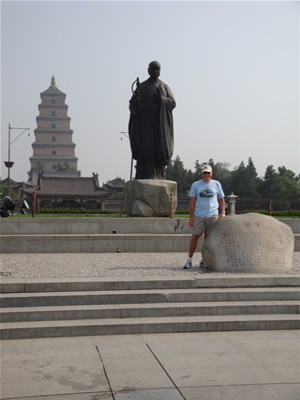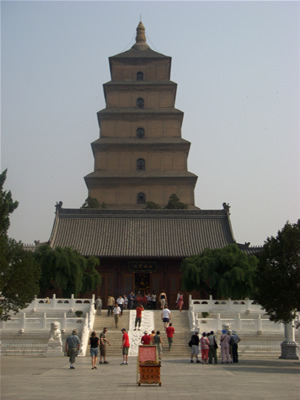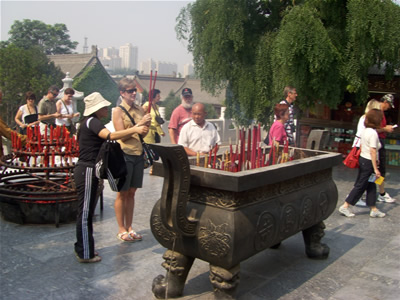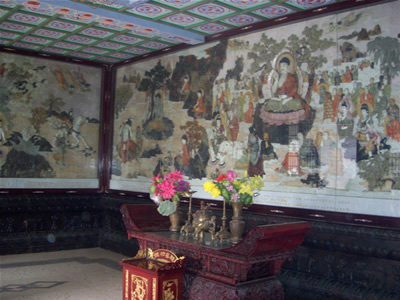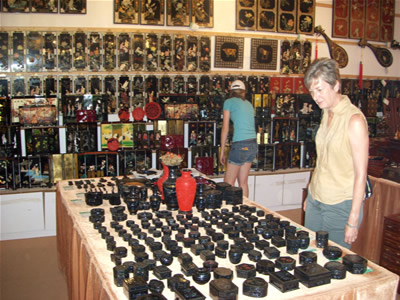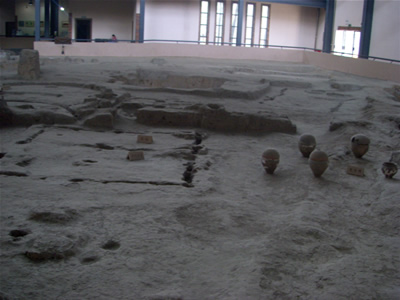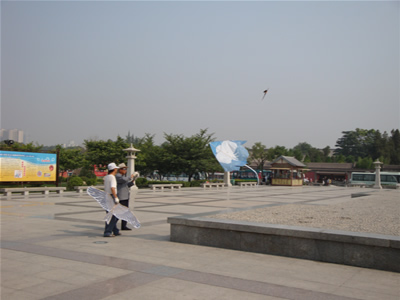China pt 6 - Xian: Ancient Capital of China
The airport at Xian was nice but it was definitely smaller and older than the one in Beijing. This time it was easy to find our guide, Miss Kathy. On our drive to the hotel we learned that Xian is a city of nine million people. It is famous because it was the capital of China from the Qin dynasty in 220 BC off and on for over a thousand years. It is also considered to be the official start of the Silk Road, the overland route through central Asia that was the only link between China and the West for over two thousand years. That makes it a tourist destination primarily for its history. Our first evening in Xian did not have any scheduled activities, but our guide offered to take us to a restaurant to try a dumpling feast which is the local specialty. We dedided that we didn't want anything exotic for dinner so we declined and just had dinner at our hotel. We may be adventurous travelers but we are not adventurous eaters. We had western cuisine for dinner. We were staying at the Hyatt Hotel which was right in the center of the city. It was ok but not great for a five star international hotel (or for the price they were charging). The Raffles Hotel in Beijing was definitely nicer.
The next morning after breakfast Miss Kathy and our driver picked us up. It was going to be a very busy day. Our first stop was the Big Wild Goose Pagoda. This pagoda is one of the most famous in China and was first built during the Tang dynasty in about 650 AD. The original pagoda partially collapsed about 50 years later and the current structure was then built. It was damaged again in a great earthquake in 1556 but was restored by the Ming dynasty. Normally it was possible to climb the steps to the top of the pagoda but because of the major earthquake in Sichuan just a few weeks before our visit, the tower was closed while the structure was being evaluated for damage. Still pretty amazing that it is standing after all this time in a region that can have strong earthquakes.
The pagoda is part of the DaCi'en Temple complex and is surrounded by an active monastery where many monks live. Getting in turned out to be a somewhat of a challenge. We stopped at the official tourist shop just outside the grounds to buy our tickets. We were looking at the souvenirs while Kathy was trying to buy our tickets. But the people told her that she had to go to a ticket office way on the other side of the complex. Ok, we waited while she went to get the tickets. She came back about fifteen minutes later quite irritated because it turned out she had been in the right place the first time. The vendors sent her away because they thought we were going to buy something. They usually quote a very high price to foreigners. When they are with a local who is a guide or friend, they can warn the tourists that the price is too high. So they sent her away while we were looking. We thought that was a bit underhanded so we didn't buy anything from them. It was too bad as they had some nice stuff that we didn't see anywhere else. Kathy was pretty mad. But I thought it was kind of funny to get sent on a Wild Goose Chase at the Wild Goose Pagoda.
Just outside the entrance was an open area with a statue of Xuanzang, the Buddhist monk who traveled the Silk Road to Xian and proposed building the pagoda to the emperor. In the square there were several people flying kites. That seemed to be a popular activity as we saw people flying kites just about everywhere in Xian that there were public open spaces. The kites were usually very colorful and quite elaborate. Most of the people flying them had serious gear. This was not tie a rag on the end of a paper kite that you buy at the dimestore like when I was a kid.
Once inside you approach the pagoda along a north/south pathway just as at all the temples and palaces in Beijing. Right in front of the pagoda is a place to make offerings to the Buddha, either by lighting candles or burning incense. Kathy is a Buddhist so she made an offering. She said that when you made the offering you could make a request of the Buddha. Sandy and I bought candles at the booth nearby and gave our offerings and made our requests. I went first and didn't get it right. Apparently after placing your candles as an offering you fold your arms and bow three times. I only did it once. Oh well. So much for my request. But Sandy got coaching from Kathy and one of the monks there and got it right. Then we strolled around the grounds. One building had a beautiful jade wall mural that told the story of the Buddha's life. There were also some beautiful gardens.
After the temple we made a shopping stop. Xian is famous for its lacquer-finished wood products. We went to a factory where they made all kinds of items out of wood that were then finished with lacquer and often had designs painted on them or added with jade sculptures attached to the wood. These ranged from small jewelry boxes to decorative wall hangings to large wooden screen panels. Some of them were absolutely fantastic. We ended up spending quite a bit of time there as we were really tempted to buy one of the screens. While they weren't cheap, they seemed very reasonable for what you got and they would ship directly to our apartment in Singapore. We negotiated and deliberated for a while but didn't come to a decision. We decided to think about it for a while.
Then it was back to sightseeing. Next we went to the Banpo Museum. This museum is built over the site of an excavation of a neolithic village from 7000 years ago. It was discovered in the 1950's by construction workers who were building a power plant. Kathy gave us a great tour explaining about the village. We could see the outline of the original huts, living and working areas, burial grounds and the large moat around the village. The museum had pictures and models that showed what the village had looked like 7000 years ago. There were displays of pottery from the village, including a fascinating design for a water jug. When you put it in the water, it was balanced so that it tipped over and began to fill up. When it filled with water it tipped back upright and you could grab it by the handles to take it out of the water. Obviously there were clever engineers even back then. We also saw samples of primitive markings that are the oldest known examples of what eventually evolved into Chinese writing. I thought it was mind-boggling to be looking at places where people lived so long ago.
Just outside the museum was a shop that featured peasant art from the village of Huxian near Xian. In the 1950's this village became famous for paintings that were produced by some of the peasants living there. During the Cultural Revolution this was further promoted as evidence that the common people could produce art just as the educated elite had. Today the village is known as an artists enclave and is a national tourist attraction. We didn't have time to visit the village but we did tour their shop next to the Banpo museum and bought two pictures of Chinese countryside scenes that we really liked.
It was a very busy morning. Now it was time for lunch and our visit to the Terra Cotta Warriors. But that needs a whole post just by itself.
